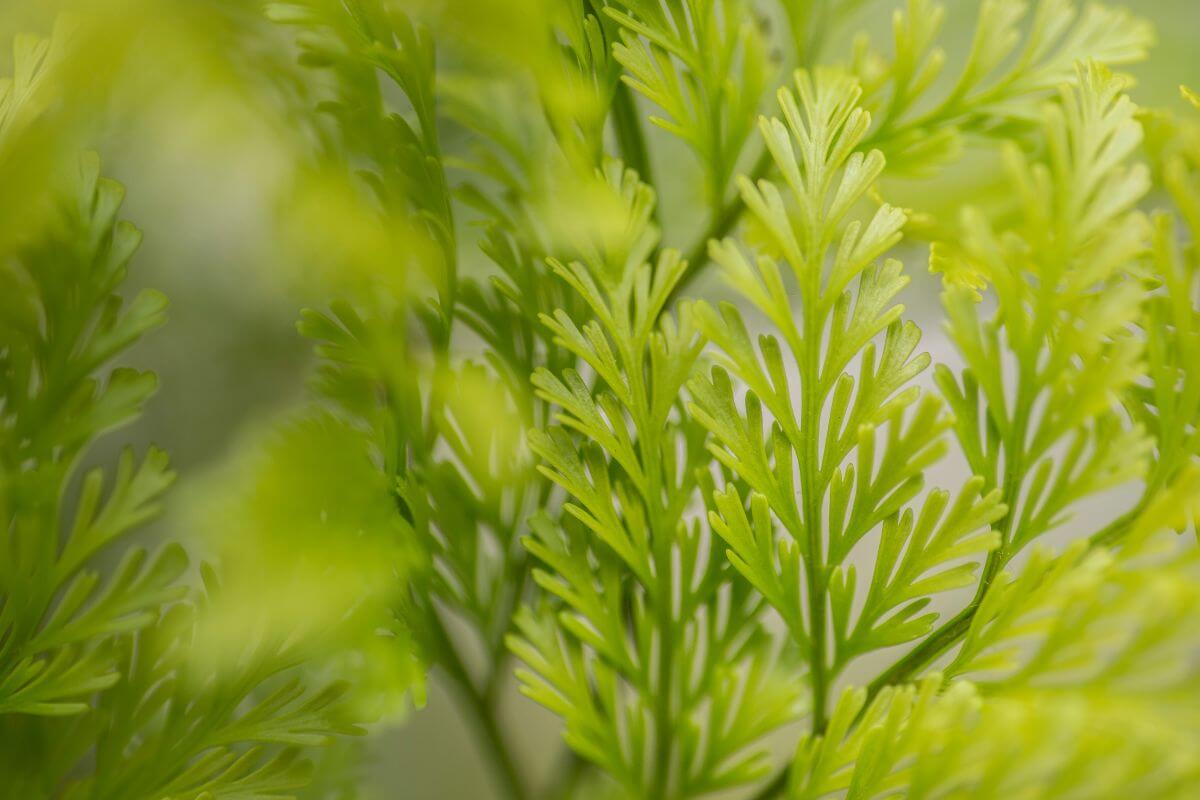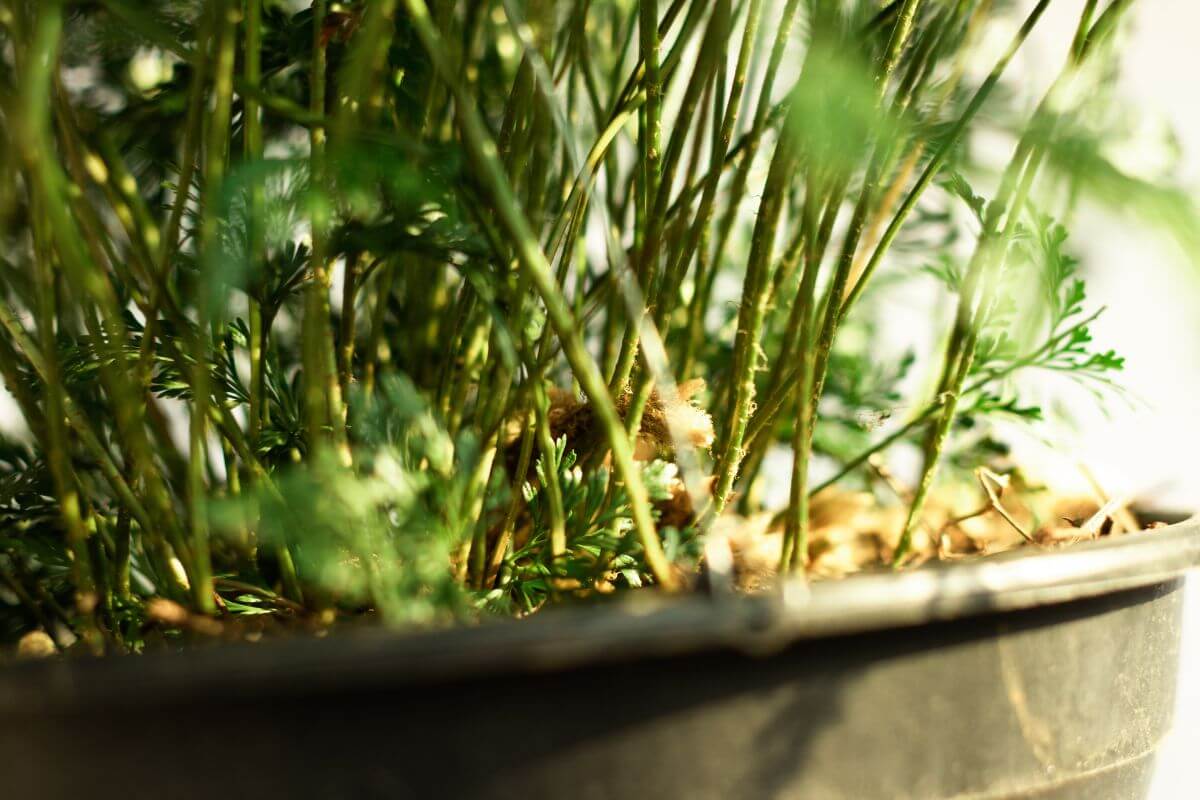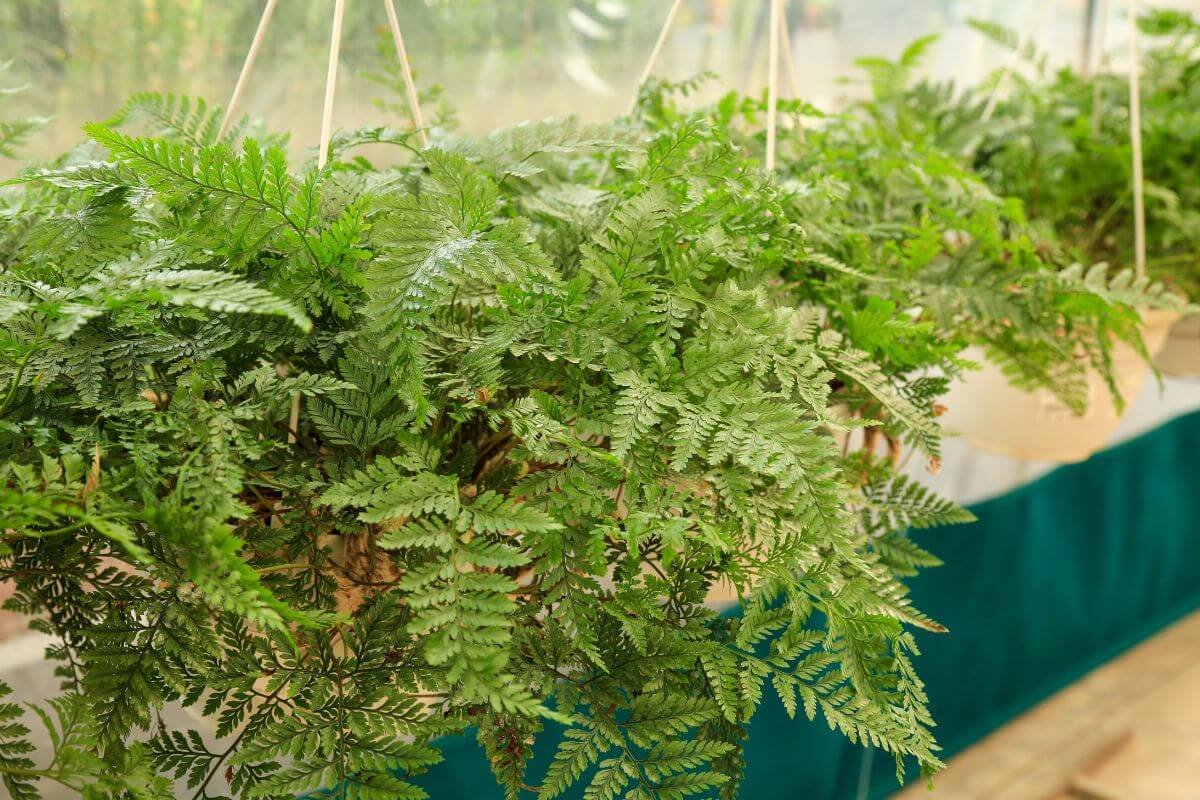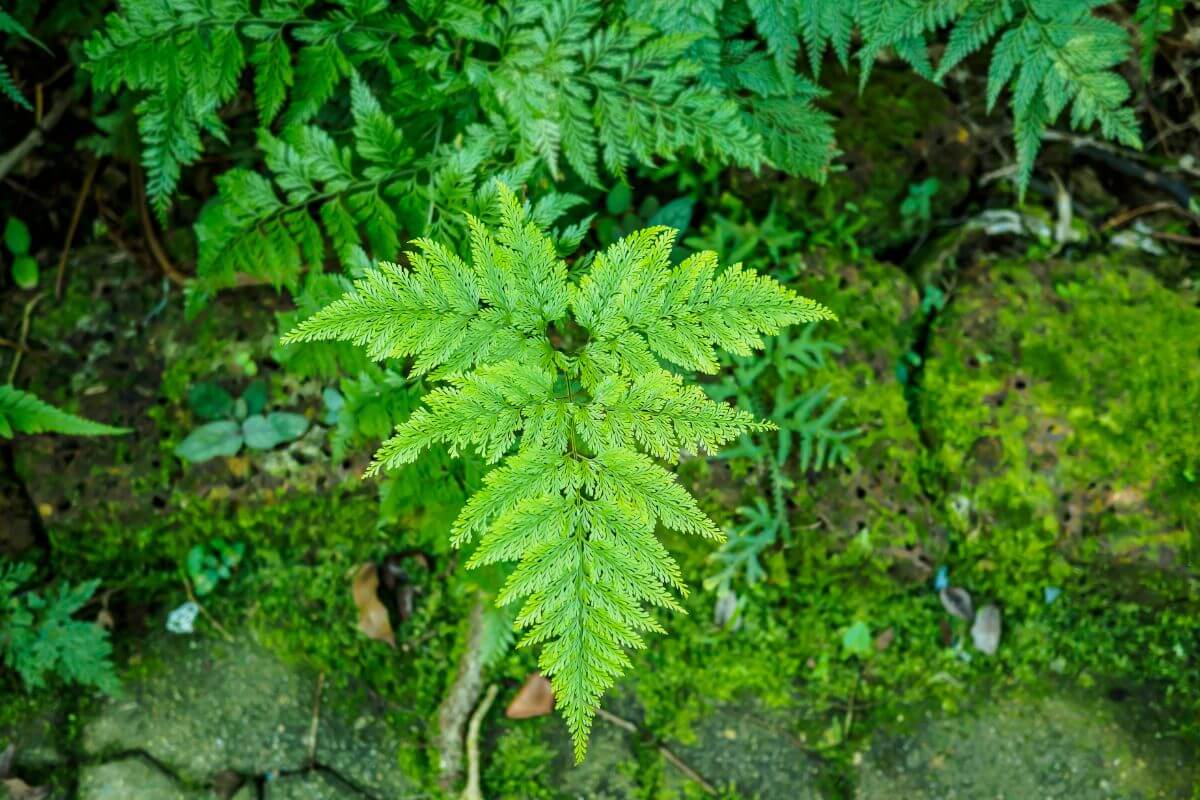The Rabbit’s Foot Fern is native to Fiji and can be grown indoors or outdoors, while enjoying a long lifespan. This houseplant gets its name from the plant’s rhizomes that are soft, fuzzy, and furry – like a rabbit’s foot.
This article will show you how to care for and grow the rabbit’s foot fern houseplant.
Rabbit’s Foot Fern Overview

The perennial evergreen fern Davallia fejeensis is more commonly known by its popular names Rabbit’s Foot Fern and Hare’s Foot Fern.
A slow-growing plant, this fern grows on the surface of the soil. The furry rhizomes also grow in a variety of shades from yellow to brown, and sometimes gray. Foliage can be light to dark green in color and has a lacy look to it.
These ferns are easy to grow as houseplants and are stunning when cultivated in hanging plants. If you wish to cultivate one outside, it will need a shady location and a warmer climate such as those in USDA hardy zones 10 and 11.
If you do not reside in those zones, grow your fern indoors, especially if the temperatures in your area drop below 55° Fahrenheit. These are not plants that can weather direct sunlight exposure or frost, although they are quite resilient.
Like orchids and bromeliad plants, the Davallia fejeensis is an epiphyte plant. They will capture any necessary nutrients from the air and rain through its green fronds and rhizomes. In its natural habitat, you’d probably find it growing on trees or rocks, as opposed to the ground soil.
Rabbit’s Foot Fern Care Guide
Where should you grow this epiphyte? In bright indirect light indoors, or if your weather permits it, in a nice shady spot outdoors.
Hanging baskets are ideal for a covered porch or patio, or a nice shallow pot.
Growing Medium for the Rabbit’s Foot Fern
A rabbit’s foot fern, as an epiphyte does not require soil to survive or grow. If you do choose to cultivate it in the soil, know the pH should be neutral.
Also, keep in mind that rhizomes cannot tolerate soggy soil. You will need a well-draining soil mix that also retains moisture at the same time.
An orchid soil mix is a good choice, as is pine bark. If you prefer to mount your fern on a log or piece of wood, use sphagnum moss or peat moss.
Light for the Rabbit’s Foot Fern

These ferns thrive in indirect sunlight and love shade. For this reason, they are ideal for indoor cultivation.
A west, east, or north-facing window can offer bright indirect lighting. South-facing windows should be avoided as they receive the most direct light.
Outdoors, cultivate your rabbit’s foot fern in full shade. Direct exposure to sunlight will burn fronds and the characteristic rhizomes will dry out.
Water and Humidity for the Rabbit’s Foot Fern
The rabbit’s foot fern can take its water from the air or rain because it is an epiphyte. When cultivated indoors, keep the soil moist, but not soggy.
Watering with collected rainwater is ideal as this mirrors its natural habitat. A rainwater shower from above will be enjoyed by the plant.
If you mount your fern on a rock or piece of wood, it will require daily moisture, so misting can help with this. You need to ensure that both the fronds and the fuzzy rhizomes do not dry out. This will be especially true if you live in a dryer climate.
Humidity will also be a must. As an epiphyte that takes its moisture from the air, it will need high humidity levels. A steamy bathroom with good lighting is an ideal room.
A humidifier is an alternative to increasing humidity levels, as well as grouping plants together or using a wet pebble tray underneath your fern. When raising ferns, getting a humidity monitor can be incredibly useful.
Temperature for the Rabbit’s Foot Fern
Extremes in temperature, whether cold or hot can damage your fern. The ideal temperature range measures between 60° and 75° Fahrenheit.
Fertilizer for the Rabbit’s Foot Fern

During the growing season, your rabbit’s foot fern will need a feeding every two to three weeks. Use a liquid organic fertilizer that is diluted to half strength. Avoid chemical or synthetic fertilizers.
Repotting and Pruning the Rabbit’s Foot Fern
The rabbit’s foot fern likes to be a bit (but not excessively) rootbound. In fact, you’ll see the rhizomes sprouting on the soil bed surface and wandering over the sides of your fern’s container.
When the fern becomes too rootbound, it will slow its growth considerably and this will be the time to repot. Ideally, repotting should be carried out in the spring.
A new pot should not be more than a couple of inches larger than its current pot. Do not bury the fuzzy rhizomes. Burying them will put them at risk of rotting.
Pruning is not a necessity with this plant. Just trim off browning or yellowing fronds or frond tips. This will encourage new growth.
Propagation of the Rabbit’s Foot Fern

Rabbit’s foot fern can be easily propagated by division. Remove your fern from its container and gently separate the rhizomes. Then repot or mount your new specimens.
You can also use a cutting to propagate. Take a four-inch cutting of a rhizome with at least one frond attached. Spray it with a light coating of rooting hormone and mount it or place it atop a moist soil bed. Mist your cutting daily until new growth emerges.
Rabbit’s Foot Fern Pests and Problems

Like just about all houseplants, a rabbit’s foot fern cultivated indoors will be susceptible to aphids, fungus gnats, mealybugs, scale insects, spider mites, and whiteflies.
Manual removal of infected fronds and pests is ideal, but you can also use an insecticidal soap or organic pesticide like neem oil that is diluted. Avoid drowning them in pesticides, it should be used sparingly.
A common problem for ferns can be leaf drop when the plant loses its fronds, leading to death. This can happen when environmental temperatures drop below 55°F. If you are cultivating outdoors on a porch or patio, better to move them indoors when temperatures fall.
Should temperatures rise above 75°F, you will need to mist daily and water frequently to prevent your plant from drying out completely.
Brown fronds indicate low humidity or root rot from overwatering. Yellowing fronds or fronds with brown tips are symptomatic of a lack of moisture or direct sunlight exposure.
If fronds become pale and growth is slow, your fern may be lacking nutrients, or there may be too much sun. Drooping or limp fronds are an indication of overwatering.
Rabbit’s Foot Fern Toxicity and Pets
The rabbit’s foot fern is non-toxic to cats and dogs, so you don’t need to worry about your pets.
Rabbit’s Foot Fern Care Final Thoughts
The rabbit’s foot fern has survived through many centuries and continue to thrive today. The only thing they require is some care and attention during the growing season. It is easy to grow and maintain, making it perfect for beginners who want to add something unique to their home décor.
Here are other great ferns and houseplant care guides:
- Hawaiian Ti Plant Care Guide
- Norfolk Island Pine Care Guide
- Boston Fern Care Guide
- Bird’s Nest Fern Care Guide
- Devil’s Backbone Plant Care Guide
Rabbit’s Foot Fern Care FAQs
How do you take care of a rabbit’s foot fern?
Take care of a rabbit’s foot fern by watering regularly, keeping it well lit, and providing good air circulation. Keeping the soil moist is key.
What kind of light does a rabbit’s foot fern need?
The rabbit’s foot fern needs bright indirect light. For best results, keep it near windows where it receives plenty of filtered sunlight.
Why is my rabbit’s foot fern dying?
Your rabbit’s foot fern could be dying for a number of reasons. It could be that it doesn’t have enough light, too much direct sunlight, has a lack of water, or has too much water. Keeping a journal in the early life of your plant will help you assess how things have been going.
Can rabbit’s foot fern live outside?
Yes, the rabbit’s foot fern can survive in outdoor conditions if given proper care. Keep it away from extreme heat and cold as these extremes can cause damage. You’ll also need to provide adequate amounts of water and fertilizer for continued active growth. Make sure it has bright light and a humid environment as well.
How big can a rabbit’s foot fern get?
The rabbit’s foot fern can grow up to 12 inches long with a spread of 6 inches wide. In its native Fiji environment, it can grow even larger, up to about 2 feet tall.
How often should I water my rabbit’s foot fern?
Water your rabbit’s foot fern every two weeks when it first comes into bloom. After blooming stops, give it one more time. If you notice any signs of stress such as yellowing leaves, droopy fronds, or discoloration around the base of the stem, then stop giving it water until those symptoms subside. Also keep an eye on dry soil as it could be a lack of water. Check the top inch of soil to see if it’s dry and if you need to add water to keep it moist.
Is the rabbit’s foot fern toxic?
No, rabbits’ feet fern isn’t poisonous to animals. They’re safe for both indoor and outdoor cultivation. Feel free to grow them if you have pets and children. But even though they’re not toxic, it’s still a good idea not to freely eat the plant.


